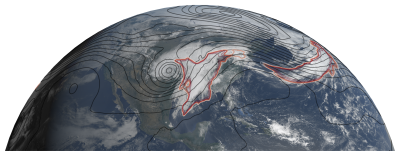Definitive Evidence that Atmospheric Rivers East of the Rockies are the Same as their West Coast Counterparts
A new study by researchers at Indiana University and Lawrence Berkeley Lab shows that atmospheric rivers (ARs) in the eastern half of the U.S. systematically occur in conjunction with large-scale weather patterns known as midlatitude cyclones.
Atmospheric rivers and their impacts are well-studied on the West Coast of the U.S., and there is increasing evidence that they are important for the eastern half of the country, too. It was not clear, however, whether western and eastern U.S. ARs have the same meteorological drivers. This study demonstrated that knowledge about western U.S. ARs can translate across the U.S.
Atmospheric rivers (ARs) are a weather pattern that brings high amounts of atmospheric water and winds in a relatively narrow region. ARs are typically considered a “West Coast” phenomenon, largely because the majority of the scientific research on ARs has focused on ARs in western coastal regions: particularly the western United States (US). ARs occur in continental interiors, but there has been some debate about whether these ARs represent the same type of weather as those in western coastal regions. This paper uses two objective methods for identifying ARs and finds times when ARs are present in three locations in the eastern half of the US: Norman, OK, Bloomington, IN, and Washington, DC. Examination of weather conditions during these AR times shows remarkable similarity to conditions associated with west coast ARs. This gives strong evidence that ARs do occur in the eastern half of the US. This result is important because it suggests that ARs may be important for water resources and extreme weather in the eastern half of the US, just as they are in the western US. This result also suggests that ARs may be important for water resources and extremes in other continental interiors.

